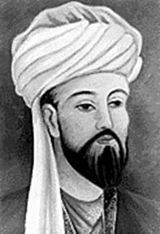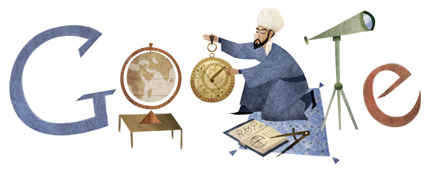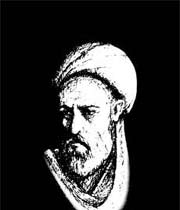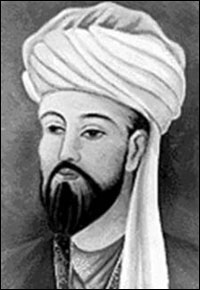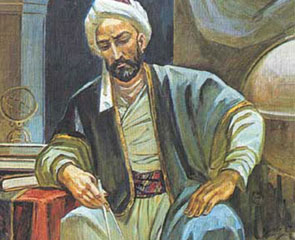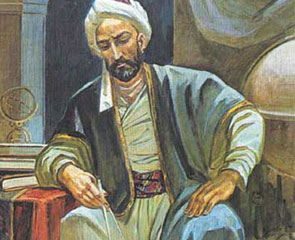al-Tusi, Khwajah Nasir (1201-74)
While philosophical activity in the Islamic west virtually ceased after Ibn Rushd at the close of the sixth century ah (twelfth century ad), it experienced renewed vigour in the east through the intellectual efforts and political involvement of Nasir al-Din al-Tusi. Although primarily a reviver of the peripatetic tradition of Ibn Sina, he was also possibly influenced by the ideas of al-Suhrawardi. He defended Ibn Sina from the criticisms levelled against him from the direction of theology, notably by Fakhr al-Din al-Razi, made a significant contribution to the acceptance of metaphysical argumentation and terminology in Twelver Shi'i theology, brought the ethical tradition of Ibn Miskawayh and the philosophers into the centre of Islamic ethical discourse, and had a lasting effect on the study of the exact sciences in Islam through both his original contributions to mathematics and astronomy and the observatory at Maraghah which the Mongol Khan Hülegü established for him.
Intellectual development
Logic, metaphysics and theology
Ethics, mathematics and the natural sciences
1. Intellectual development
Al-Tusi's intellectual development cannot be divorced from the drama of his own life, and the catastrophe of the Mongol invasion of the Islamic east. From his birth in Tus in Khurasan in northwest Iran in ah 597/ad 1201 up to his middle or late twenties, al-Tusi lived in a Twelver Shi'i milieu, in a family whose idea of learning was, according to his own account, the study of the religious law, and whose behaviour was measured by its practice. His jurist father, however, was sufficiently broad-minded to encourage him beyond scholastic studies to the philosophical and natural sciences, and to acquaint himself with the doctrines of other schools and sects. To study philosophy, al-Tusi went to nearby Nishapur, where he was taught by a scholar whose teaching lineage went back to Ibn Sina. Early in his career, as al-Tusi himself later wrote, he was not convinced that the intellect could answer the ultimate metaphysical questions, since it would thereby be inquiring into its own origins, something of which it would be incapable. Perhaps as a way out of his perplexity, and quite possibly as the result of sectarian connections through an uncle, he turned to the Isma'ilism of his day, which had been influenced by the Neoplatonic speculations of Isma'ili thinkers in the third and fourth centuries ah (ninth and tenth centuries ad). Isma'ili doctrine turned on the concept of an infallible Imam, without whose guidance, it claimed, the unaided intellect was unable to reach the truth.
From his late twenties or early thirties, al-Tusi was in the service of the local Isma'ili leaders of northern Iran, writing a number of theological and philosophical works for them in both Persian and Arabic and beginning his contribution to a major revival of Peripatetic philosophy in eastern Islamic lands. With the Mongol invasion of Iran in the middle of the thirteenth century the Isma'ili strongholds were destroyed, and al-Tusi found himself involved in the negotiations leading to the surrender of the Grand Isma'ili Master to the invaders. His efforts were appreciated by the Mongol conqueror Hülegü, who took him on as an advisor, in which capacity he assisted at the sacking of Baghdad in ah 656/ad 1258. Later al-Tusi was put in charge of religious endowments and affairs. Hülegü also had the great observatory and library at Maraghah built for al-Tusi, where he led a team of scientists and mathematicians from as far away as China. It is clear that immense resources were put at his disposal for this project, where the teaching and study of philosophy went on hand in hand with that of the exact sciences.
The end of his Isma'ili period also marked al-Tusi's turn (or return) to Twelver Shi'ism, and the last period of his life witnessed not only a remarkable output of scientific works but also a reformulation of Imami theology in philosophical terms which was as influential in the Shi'i world as was that of Fakhr al-Din al-Razi in the Sunni. Al-Tusi died in ah 672/ad 1274 in Baghdad, in the same year as Thomas Aquinas. He was buried according to his last wishes beside the shrine of the seventh Twelver Imam, Musa ibn Ja'far, in Kazimayn just outside Baghdad. Among his most remarkable students were the philosopher Qutb al-Din al-Shirazi (d. ah 710/ad 1310) and the Imami jurist and theologian, the 'Allamah al-Hilli (d. ah 726/ad 1325).
If in his early life al-Tusi believed in the need for reason to be sustained by a non-rational (or supra-rational) guarantor, his move to Twelver Shi'ism, with its doctrine of the hidden, inaccessible Imam, indicates a growing strength in his convictions about the ability of the intellect. His sectarian shifts have given rise to much argument concerning his genuine doctrinal loyalties, but throughout his life there runs a consistent philosophical thread whose main characteristic was the defence, rehabilitation and elaboration of Ibn Sina's method and theories. It is through his interpretations in texts, epitomes, commentaries and refutations that subsequent generations in the Islamic east have approached their understanding of Ibn Sina. His output as an author in both Arabic and Persian was prodigious, including lasting contributions to logic, metaphysics, ethics, mathematics and astronomy.
2. Logic, metaphysics and theology
Al-Tusi's main contribution to logic is contained in his Persian Asas al-iqtibas (The Ground for the Acquisition of Knowledge), written during his Isma'ili period. It is divided according to the habitual ten sections of the organon of the Islamic world, and its discussion of substance has recently attracted attention (Morewedge 1975). It also stands as a testimony to al-Tusi's ability to write about technical subjects in Persian, by incorporating Arabic terminology into a fluent and graceful style. An Arabic manual of logic by al-Tusi, the Tajrid al-mantiq (Abstract of Logic), was commented on by his pupil the 'Allamah al-Hilli.
However, the major text on which al-Tusi's reputation as an interpreter of Ibn Sina's philosophy rests is his commentary on the Kitab al-Isharat (Remarks and Admonitions), written towards the end of his stay with the Isma'ilis. Al-Tusi's work was in part, at least, intended as a response to the commentary of Fakhr al-Din al-Razi on the same text. This work shows one of al-Tusi's continuing complaints, that those who attack Ibn Sina are generally ill-equipped as philosophers and that analysis can reveal their weaknesses. He is not averse to the use of polemic himself, but his insistence that a philosopher be evaluated in terms of the soundness of his argumentation and not according to preconceived ideas about conclusions demonstrates his faithfulness to Ibn Sina's own method. Thus, although on the whole defending Ibn Sina's theories, he disagrees with the latter when he sees fit. In his interpretation of emanation, for example, al-Tusi is partly in agreement with al-Suhrawardi concerning the nature of God's knowledge, although he does not entirely reject Ibn Sina's theory of identity of form between knower and known as being applicable to other existents (see Ibn Sina). God's knowledge of the First Intellect, and consequently of the entire universe, is identical with its existence through a kind of presential knowledge, while lower entities in the emanative chain derive their knowledge through forms and representations as well as through presence. Al-Tusi's commentary is clear and systematic, and is still studied with the original text because of his lucid explanations of Ibn Sina's often difficult and dense prose.
The texts discussed so far belong to al-Tusi's Isma'ili period, but the break with this past was decisively accomplished in Masari' al-musari' (The Floorings of the Wrestler), a refutation of an Isma'ili Neoplatonic text by the crypto-Isma'ili al-Shahrastani (d. ah 548/ad 1153) which attacked Ibn Sina for deviating from 'prophetic theology'. Al-Tusi's vehemently anti-Isma'ili defence of Ibn Sina is unreservedly polemical, using the same tactic of accusations of weak logic and feeble-mindedness which he had employed against al-Razi. Perhaps also a rejection of al-Tusi's own past, this text marks another stage in the development of his conviction of the superiority of philosophical thinking over religious dialectics.
Al-Tusi made several contributions to the field of metaphysical theology. The first attempt in this direction was an exposition of Isma'ili qiyama (resurrection) theology in his Rawdat al-taslim (The Garden of Submission), but of more enduring consequence was his later Twelver work, the Tajrid al-kalam (Abstract of Theology). This has been the subject of numerous commentaries down to the present century, the most important of which is the 'Allamah al-Hilli's Kashf al-murad (Disclosing the Intention). After the Tajrid, practically all Imami theological works would be expressed in the terminology of metaphysics, with Mulla Sadra eventually achieving a comprehensive and lasting fusion.
3. Ethics, mathematics and the natural sciences
There are two main works in al-Tusi's ethical output, the Akhlaq-i Muhtashami (Muhtashamean Ethics) and the Akhlaq-i Nasiri (The Nasirean Ethics), both written in Persian. The first of these was commissioned by the Isma'ili ruler (muhtasham) of Quhistan, Nasir al-Din 'Abd al-Rahman, who provided the outline and approved its contents but called in al-Tusi to do the major work because of the demands of his own political duties. This is scarcely more than a manual of ethical precepts, amply illustrated with quotations from the Qur'an, the Shi'i Imams and Greek sources. The Akhlaq-i Nasiri, the first 'edition' of which was dedicated to the same Nasir al-Din, is arranged as a work of philosophical ethics. Its divisions into three parts - ethics (akhlaq), domestic economics (tadbir-e manzil), politics (siyasat-e mudun) - set the pattern for subsequent works on practical philosophy in the Islamic tradition (see al-Dawani).
The first part on ethics is modelled on Ibn Miskawayh's Tahdhib al-akhlaq (Cultivation of Morals), of which the work was initially commissioned to be merely a Persian translation (see Ibn Miskawayh). However, al-Tusi expands on Ibn Miskawayh both in the initial section on principles, mainly a theoretical treatment of psychology (the soul), and in his subsequent treatment of character and the virtues. This first part finishes with the addition of a section on the treatment of the vices as sicknesses of the soul, and of the cures to remedy them. The sources of the second part on domestic economics are the Arabic translation of Bryson's Oikonomikos and a text by Ibn Sina, his Kitab al-siyasa (Book of Politics), while the third part, on politics, goes back to al-Farabi's Kitab al-siyasa al-madaniyya (The Political Regime) and Fusul al-madani (Aphorisms of the Statesman) (see al-Farabi). The last part contains an important section on the virtue of love (mahabba) as the cement of societies.
After al-Tusi joined Hülegü, he changed the introduction and conclusion to this work, excusing his previous praise of the Isma'ili leadership as the product of exigency. Moreover, he added that this was strictly a work of philosophy which transcended sectarian differences and was available to all. The work made available to Persian readers the Islamic ethical tradition taken from Greek philosophy but now incorporating Qur'anic material alongside the opinions of Plato and Aristotle. Justice explicitly comes to the fore as the supreme virtue running through all three parts of the book, implicitly linking it with Shi'i theology and the priority given in the latter to justice among the divine attributes; and philosophical ethics and the religious law are stated to be concerned with the same subject matter, thus affirming the intellect's capacity to view normative values in a way which could only have been acceptable at that time within Shi'i circles (see Ethics in Islamic philosophy).
Throughout his life al-Tusi was a prolific writer in mathematics and the natural sciences, and made advances in trigonometry, mathematics and astronomy. This aspect of his intellectual endeavour was eventually rewarded with the foundation of the Maraghah observatory. The result of the astronomical observations and calculations made there was the famous tables of the Zij-e Ilkhani (in Persian, but also translated into Arabic). Prior to Maraghah, the rational sciences had been cultivated by individuals with (or without) private patronage, the schools in Islam being devoted almost entirely to the law and dismissive of, if not actually hostile to philosophical activity. The setting up of the observatory and the institutionalization of the rational sciences created a demand for teaching materials, and al-Tusi was himself the author of a number of recensions (tahrir) of scientific texts as well as summaries and abridgements of theological, logical, and philosophical texts, clearly intended to supply this teaching need. Al-Tusi's lasting influence can be seen in the subsequent surge of activity in the rational sciences in the Islamic east, as well as in their gradual absorption into religious education, which in turn affected the development of theology, particularly among Shi'i scholars (see Science in Islamic philosophy).
See also: Ibn Sina; al-Razi, Fakhr al-Din; Science in Islamic philosophy
JOHN COOPER
Copyright © 1998, Routledge.
--------------------------------------------------------------------------------
List of works
(1235, 1265) Akhlaq-i Nasiri (The Nasirean Ethics), trans. G.M. Wickens, London: George Allen & Unwin, 1964. (An excellent, meticulous translation of the Akhlaq-e Nasiri, with a brief introduction and notes.)
(1242) Rawdat al-taslim (The Garden of Submission), trans. C. Jambet, La convocation d'Alamût: somme de philosophie ismaélienne (Radat al-taslîm: Le jardin de vraie foi), Lagrasse and Paris: ةditions Verdier and ةditions UNESCO, 1996. (A work of Isma'li theology.)
(1244-5) Asas al-iqtibas (The Ground for the Acquisition of Knowledge), ed. M. Radawi, Tehran: Tehran University Press, 1947. (Al-Tusi's major logical text, in Persian.)
(probably after 1246) Sayr wa suluk (Contemplation and Action), ed. and trans. S.J.H. Badakhchani, London: Institute for Ismaili Studies, 1997. (This is the autobiography which al-Tusi wrote during his stay with the Isma'ilis, and is untinged with the complaints which he later made of this period in his life.)
(before 1258) Sharh al-Isharat (Commentary on the Isharat), ed. S. Dunya in Ibn Sina, al-Isharat wa-'l-tanbihat, Cairo: Dar al-Ma'arif, 1957-60, 4 parts, 3 vols in 2; also in Ibn Sina, al-Isharat wa-'l-tanbihat, Tehran: Matba'at al-Haydari, 1957-9, 3 vols. (Both these editions contain al-Tusi's commentary as parts of Fakhr al-Din al-Razi's commentary, to which al-Tusi is responding. The Tehran edition also contains Qutb al-Din al-Razi's commentary, which sets out to adjudicate between al-Tusi and al-Razi.)
al-Tusi (probably before 1270-1) Tajrid al-kalam (Abstract of Theology). (The text of this, al-Tusi's major theological work (also known as Tajrid al-'aqa'id and Tajrid al-i'tiqad), can be found in the commentary by his pupil Hasan ibn Yusuf ibn al-Mutahhar al-Hilli, Kashf al-murad fi sharh tajrid al-i'tiqad, Qum: Jama'at al-Mudarrisin, no date.)
References and further reading
Dabashi, H. (1995) 'Khwajah Nasir al-Din al-Tusi: The Philosopher/Vizier and the Intellectual Climate of His Times', in S.H. Nasr and O. Leaman (eds) History of Islamic Philosophy, London: Routledge: 527-84. (Good introduction to al-Tusi, his work and his times.)
Ibn Sina (980-1037) Kitab al-isharat wa-'l-tanbihat (Remarks and Admonitions), trans. A.-M. Goichon, Livre des directives et remarques, Beirut: Commission Internationale pour la Traduction des Chefs d'Oeuvres, and Paris: Vrin, 1951. (A useful French translation of Ibn Sina's text with introduction and notes by the translator; also contains many of al-Tusi's explanations in the notes, as well as some of his criticisms of al-Razi.)
Madelung, W. (1985) 'Nasir al-Din Tusi's Ethics Between Philosophy, Shi'ism, and Sufism', in R.G. Hovannisian (ed.) Ethics in Islam, Malibu, CA: Undena, 85-101. (Discusses the developments of al-Tusi's ethical ideas in relation to his political involvement and religious allegiances.)
Morewedge, P. (1975) 'The Analysis of "Substance" in Tusi's Logic and in the Ibn Sinian tradition', in G. Hourani (ed.) Essays on Islamic philosophy and science, Albany, NY: State University of New York Press. (Morewedge is one of the few scholars to have made specific studies of al-Tusi's metaphysics, and this article discusses substance in the Asas al-iqtibas.)
Mudarris Radawi, M.T. (1975) Ahwal wa athar-e... Abu Ja'far Muhammad... al-Tusi... (Life and Works of... Abu Ja'far Muhammad... al-Tusi...), Tehran: Bunyad-e Farhang-e Iran. (In the absence of any comprehensive work on al-Tusi in a European language, it is necessary to turn to this Persian work which contains a comprehensive inventory of al-Tusi's works.)
